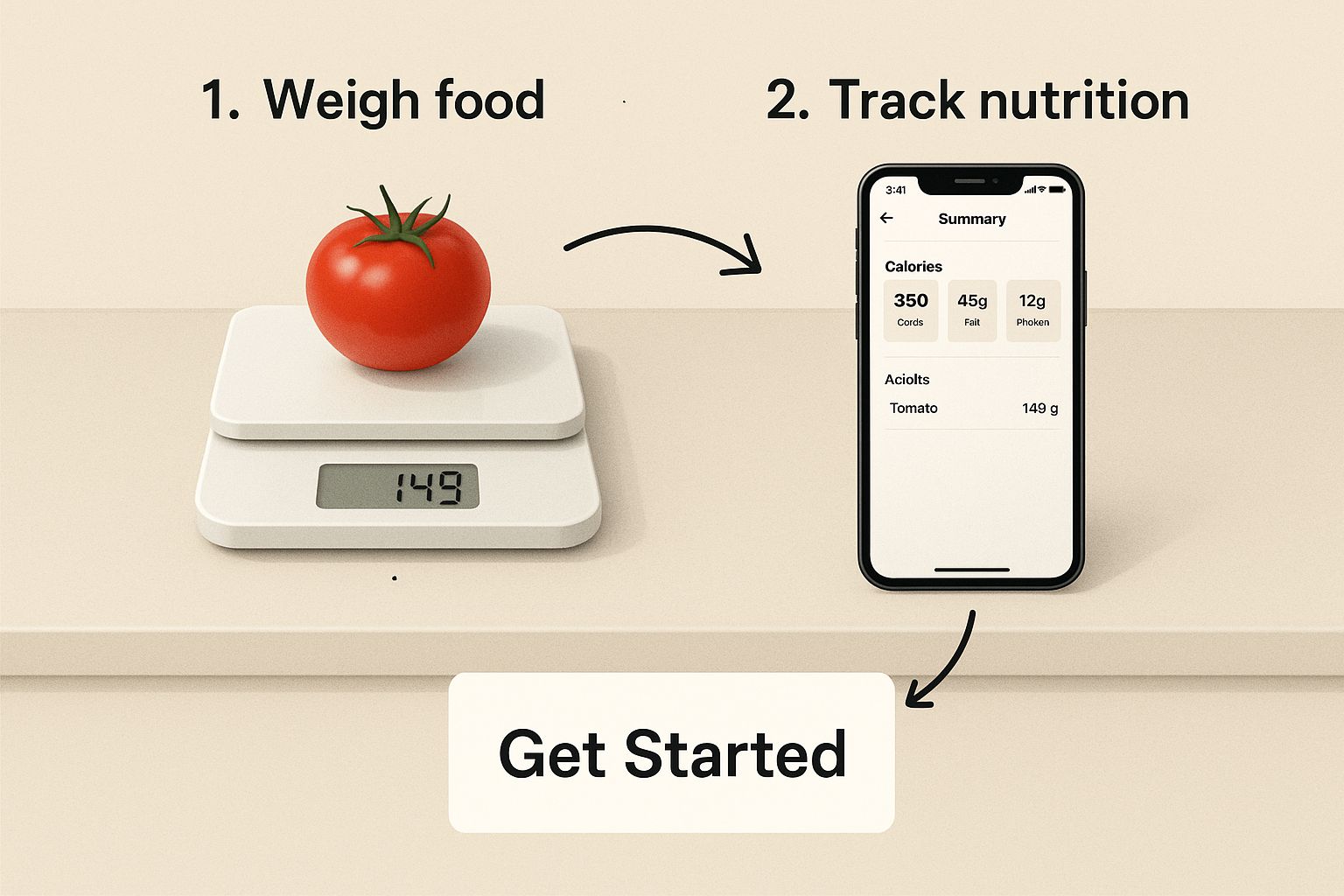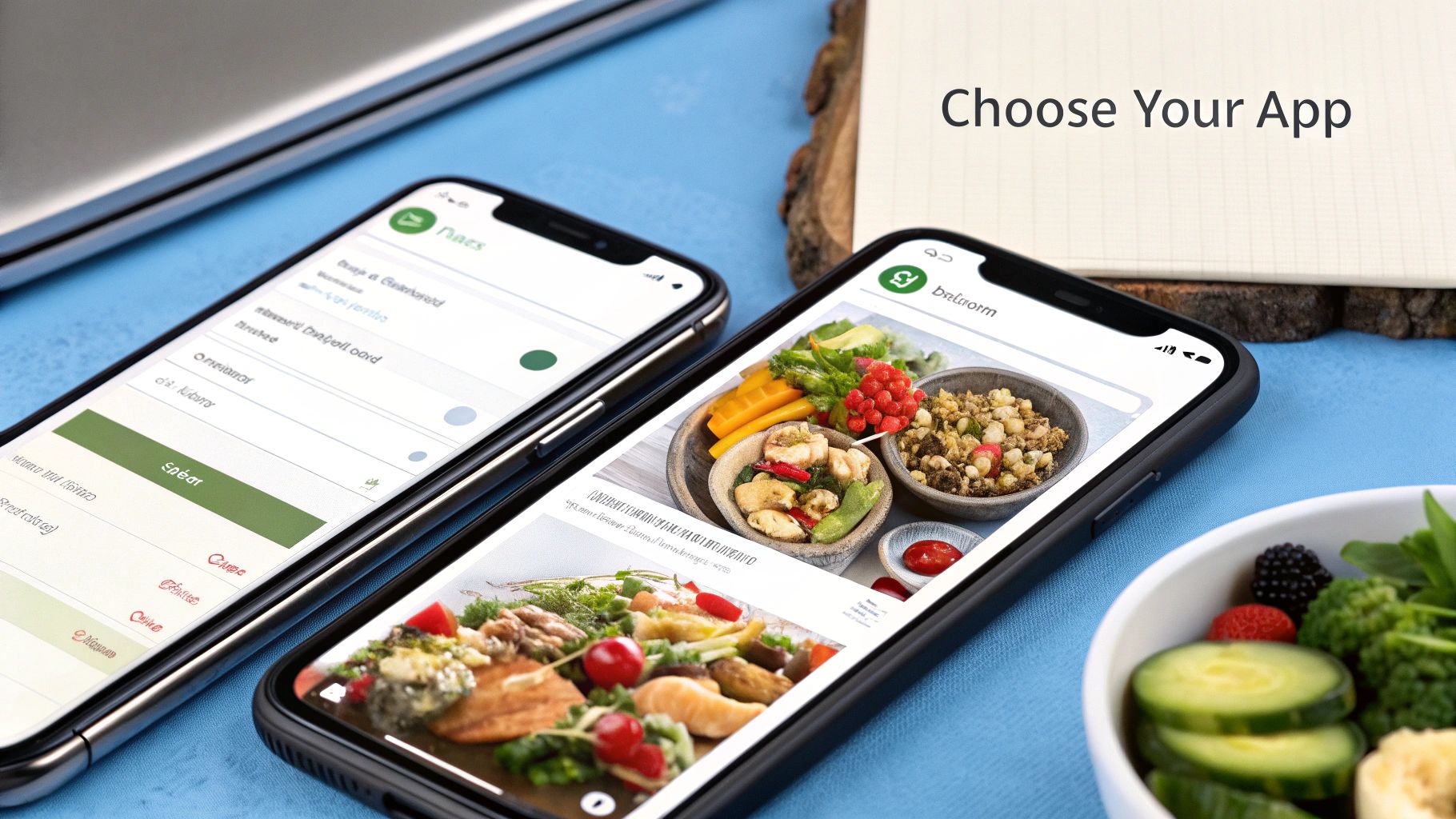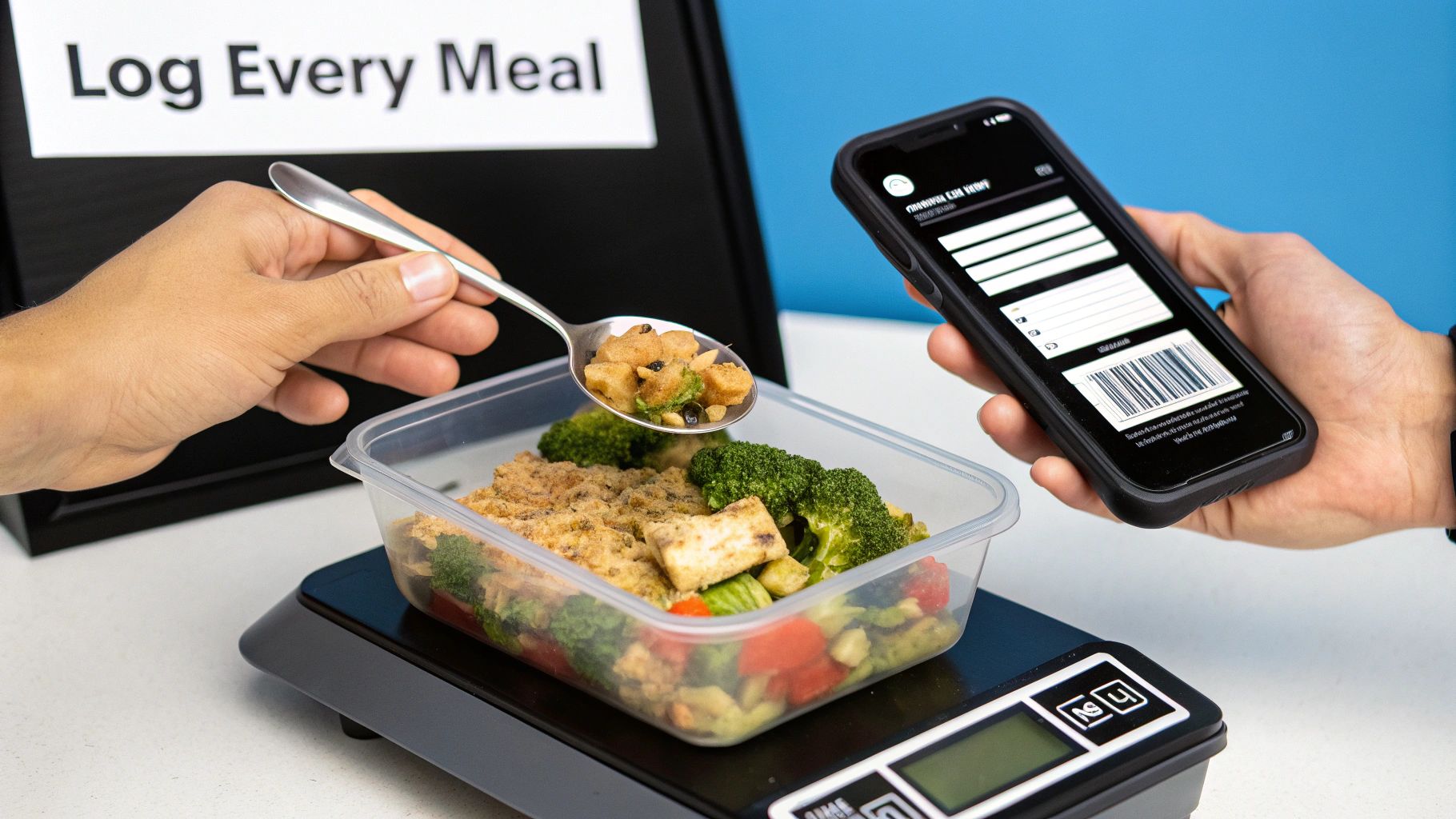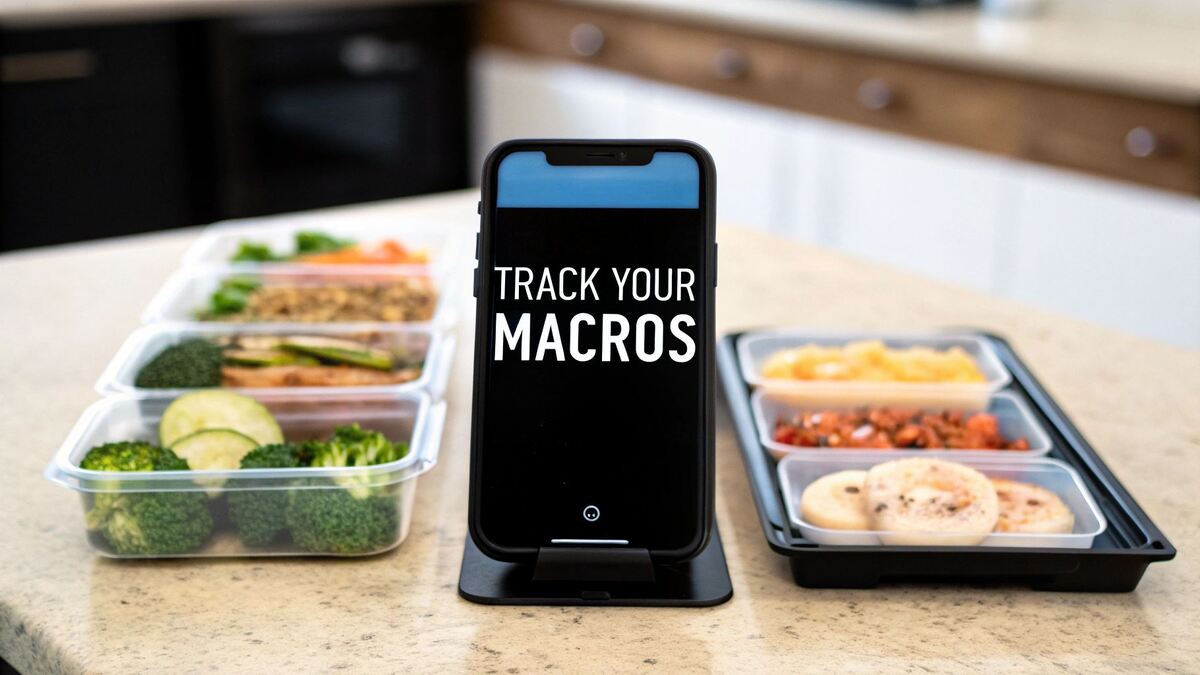How to Track Macros The Right Way
Learning how to track macros might seem complicated, but it really boils down to two things: a digital food scale and a tracking app. That's it. This combo is all you need to get a clear picture of your protein, carb, and fat intake, helping you dial in your nutrition for any fitness goal.
Think of it as simply building a new habit, one that gives you incredible control over your body's fuel.
Getting Started Without Getting Overwhelmed
Diving into macro tracking can feel a little intimidating at first, I get it. But let's reframe it. This isn't about a rigid, restrictive diet. It’s about being mindful and using real data to understand what you're eating. The objective isn't to be perfect right out of the gate; it’s to build consistency and learn what your body actually needs to perform at its best.
This approach has become incredibly popular for a reason—it works, and it's flexible. You’re not alone in this. By 2020, people were logging over 180 million food items every single day in popular apps, according to data from MyFitnessPal. It’s a mainstream tool for a reason.
Why Macro Tracking Works
The real power of tracking macros is that it’s all about you. Instead of just obsessing over a single calorie number, you're looking at the quality and makeup of those calories. This subtle shift makes all the difference.
- You can fine-tune for your goals. Want to build muscle? You'll need more protein. Training for a marathon? Carbs are your best friend. Tracking allows you to adjust your fuel source to match your objective.
- It helps improve body composition. By hitting your protein targets and managing your carb and fat intake, you can create an environment that encourages your body to burn fat while holding onto precious lean muscle.
- You learn so much about food. This is a big one. You’ll quickly develop an intuitive sense of what's in the foods you eat, which empowers you to make smarter choices for life, even on days you don't track.
This infographic lays out just how simple the initial setup is.

As you can see, you really just need a scale and an app on your phone. These are the foundational tools for building this powerful habit.
Before you dive in, let’s quickly cover the gear you'll want on hand. Having these basics ready will make the entire process feel smooth and effortless from day one.
Essential Tools for Macro Tracking
| Tool | Why It's Important | Recommended Feature |
|---|---|---|
| Digital Food Scale | Provides the accuracy needed for precise logging. Guessing portion sizes is a recipe for stalled progress. | Look for one with a "tare" or "zero" function to easily weigh food in containers. |
| Tracking App | Does all the math for you. It contains a massive food database and calculates your macros automatically. | A barcode scanner is a must-have. It saves a ton of time and reduces manual entry errors. |
| Measuring Cups/Spoons | Useful for liquids and small quantities where a scale might be less practical (e.g., olive oil, spices). | A standard set will do. No need for anything fancy. |
Having these tools at your fingertips removes friction and makes it much more likely that you'll stick with tracking long enough to see results.
The Basic Workflow
At its heart, macro tracking is a simple daily rhythm. You weigh your food, you find it in the app (often by just scanning a barcode), and you log the amount. That’s it. The app handles all the heavy lifting, tallying up your protein, carbs, and fats and showing you exactly where you stand against your daily targets.
The real magic of macro tracking isn’t in hitting your numbers perfectly every single day. It’s in the patterns and insights you gain over time, which allow you to make lasting, intelligent changes to your eating habits.
If you want to take the guesswork out of the equation entirely, you can always explore customized meal plans designed to hit your specific macro goals. A clear plan can be a great way to build consistency without having to make food decisions on the fly.
Calculating Your Personal Macro Targets
https://www.youtube.com/embed/1VBPNmHf0gU
Before you even think about logging your first meal, you need a roadmap. Calculating your personal macro targets is what gives your nutrition a clear direction, turning aimless eating into a powerful strategy built for your body and your goals. This is about more than just plugging numbers into a generic online calculator; it's about getting a handle on your body’s actual energy needs.
Your Nutritional North Star: TDEE
The entire process hinges on one key metric: your Total Daily Energy Expenditure (TDEE). Think of this as the total number of calories your body burns in a 24-hour period. It accounts for everything—from the energy you need just to stay alive (your basal metabolic rate) to your workouts and daily activity. This number is the foundation of your entire plan.
Once you know your TDEE, you can set a smart, realistic calorie goal based on what you want to achieve.
- To lose fat: You'll want a moderate calorie deficit, usually around 15-20% below your TDEE. A smaller, sustainable deficit is key because it helps you hang onto precious muscle while dropping fat.
- To build muscle: Aim for a slight calorie surplus, about 10-15% above your TDEE. This gives your body the extra fuel it needs for muscle repair and growth without packing on a ton of unwanted body fat.
- To maintain: It's as simple as eating at your TDEE. This is perfect for maintaining your current weight while you focus on getting stronger or improving body composition.
Your TDEE is your nutritional North Star. Whether you're aiming for a calorie deficit or surplus, every decision should be based on this personalized maintenance number. Drastic cuts or huge surpluses often backfire, leading to burnout or unwanted fat gain.
Breaking Down Your Macros
With a calorie target in your sights, the next move is to decide how those calories will be split between protein, carbohydrates, and fats. This is where your specific fitness goals really start to shape the plan.
Protein is non-negotiable, especially if you’re active. A solid target to shoot for is anywhere between 0.7 to 1.0 grams of protein per pound of your body weight. This macro is absolutely critical for repairing muscle, keeping you full, and preserving lean mass when you're in a fat-loss phase.
After you've locked in your protein goal, the rest of your calories will be divided between carbs and fats.
Putting It All Together: Real-World Scenarios
Let's walk through a couple of examples to see how this plays out in the real world.
Scenario 1: Fat Loss
- The Person: A 150-pound individual who is moderately active.
- The TDEE: Let's say it's about 2,200 calories.
- The Goal: A 20% deficit, which brings the daily calorie target to 1,760 calories.
- Protein: We'll aim for 0.8g/lb. So, 150 lbs x 0.8g = 120g of protein (which is 480 calories).
- Leftover Calories: 1,760 - 480 = 1,280 calories to be split between carbs and fats.
Scenario 2: Muscle Gain
- The Person: A 180-pound individual who is very active.
- The TDEE: Roughly 3,000 calories.
- The Goal: A 10% surplus, setting the new target at 3,300 calories.
- Protein: We'll go for 1.0g/lb. So, 180 lbs x 1.0g = 180g of protein (that’s 720 calories).
- Leftover Calories: 3,300 - 720 = 2,580 calories for carbs and fats.
You’ll notice the carb and fat split is flexible. Some people feel and perform better with higher carbs, while others prefer more healthy fats to help with satiety. This often comes down to personal preference and can be set using a percentage-based split. If you need a refresher, this guide on basic percentage principles is a great help.
And if you’re not sure how to split those remaining calories, our guide to a well-rounded balanced diet offers a fantastic, evidence-based starting point.
Finding the Right Macro Tracking App for You

Alright, you've got your macro targets. Now comes the part where the rubber meets the road: choosing how you're going to track everything. The best tool isn't always the one with the most bells and whistles. It's the one you’ll actually stick with day in and day out.
Think of it like this: your tracking app is going to be your daily sidekick on this journey. It needs to fit your lifestyle and personality. Some people love digging into endless data points, while others just want a simple, get-it-done interface. Let's look at the top players so you can find the one that clicks for you.
Comparing Popular Macro Tracking Apps
While there are tons of apps out there, a few names always bubble to the top: MyFitnessPal, Cronometer, and MacroFactor. Each one has its own philosophy and is built for a slightly different kind of person.
Here’s a quick side-by-side to get us started.
| App Feature | MyFitnessPal | Cronometer | MacroFactor |
|---|---|---|---|
| Best For | Beginners & Social Integration | Data Enthusiasts & Micronutrients | Serious Lifters & Automated Adjustments |
| Food Database | Massive, user-generated | Verified, accurate, but smaller | Verified, fast growing |
| Key Feature | Huge community and recipe import | Detailed micronutrient tracking | Dynamic TDEE and macro adjustments |
| User Experience | Easy to start, but can be cluttered | Clean, data-focused, precise | Sleek, modern, and efficient |
| Pricing Model | Freemium with a Premium option | Freemium with a Gold subscription | Subscription-only (no free version) |
That table gives you the 30,000-foot view. But what you really need to know is how each one feels to use every day. Your choice boils down to what you care about most: community, pinpoint accuracy, or smart automation.
Deep Dive Into Each Platform
MyFitnessPal is the OG, the one most people start with. Its biggest draw is the absolutely gigantic, user-created food database. If you can eat it, someone has probably logged it, which makes tracking restaurant meals or obscure grocery items a breeze. The flip side? All those user entries can be wildly inaccurate. You have to be careful.
Cronometer is for the person who values accuracy above all else. Their database is professionally curated and verified, so you know the numbers are solid. Its real superpower, though, is its incredibly detailed micronutrient tracking. If you’re concerned with vitamins, minerals, and the true nutritional quality of your diet, this is your app.
Then there’s MacroFactor, a newer app that has quickly built a loyal following, especially among lifters. Its killer feature is a smart algorithm that constantly calculates your personal energy expenditure based on what you log and your daily weight. It then automatically adjusts your calorie and macro targets for you each week. It completely removes the guesswork of when and how to change your plan.
At the end of the day, ask yourself this: "Which tool will make my life easiest?" Whether that's a lightning-fast barcode scanner or the confidence of a plan that adjusts itself, pick the app that makes being consistent feel almost effortless.
The Old-School Approach: A Manual Spreadsheet
Not a fan of apps or subscription fees? You can absolutely go old-school with a simple spreadsheet. Armed with a digital food scale and a reliable source for nutrition info (the USDA FoodData Central is excellent), you can log everything manually.
It's definitely more work upfront, but it gives you total control and a much deeper understanding of the food you eat. You basically become the app, and that hands-on process can be an incredibly powerful learning experience.
Making Daily Food Logging a Sustainable Habit

Knowing your macro targets is a great start, but consistently hitting them is where the magic really happens. This is the part where you turn tracking macros from a chore into a seamless, sustainable habit. The secret isn't about being perfect—it's about building a reliable routine that works for you, even on your most hectic days.
The key to long-term success is making the process as frictionless as possible. The more you can simplify or automate, the higher the chance you'll stick with it. It’s the small, practical efficiencies that compound over time, creating an effortless daily rhythm.
Master the Everyday Workflow
Your tracking app is probably loaded with features designed to make your life easier. The trick is to actually use them. Leaning into these tools is the first step toward making daily logging feel like second nature. Forget about manually searching for every single item you eat.
Here are a few game-changing habits you can start building right away:
- Scan Everything with a Barcode: If it comes in a package—from yogurt to protein powder—use the barcode scanner in your app. It’s dramatically faster and far more accurate than typing in a product name and guessing which database entry is the right one.
- Create Custom Recipes: Make the same homemade chili or protein smoothie all the time? Invest five minutes to build it as a "Recipe." Log each ingredient just once, and from then on, you can add the entire meal with a single tap, only needing to enter your portion size.
- Use the "Copy Meal" Feature: If your breakfast is a carbon copy of yesterday's, don't waste time re-entering it. Most apps let you copy a meal from a previous day directly into your current log.
These small actions shave precious minutes and mental energy off your day, turning what feels like a tedious task into a quick, simple check-in.
The goal is to make tracking so easy that it requires almost no willpower. When you can log an entire meal in under 30 seconds, it stops feeling like a chore and simply becomes part of your routine, like brushing your teeth.
Navigating Real-World Tracking Challenges
It’s one thing to be precise when you’re at home with your trusty food scale, but real life often happens outside the kitchen. This is where a lot of people get discouraged and fall off the wagon. The trick is to have a game plan for these less-than-perfect scenarios.
Logging something complex like a homemade stew can feel overwhelming. The best practice here is to weigh each raw ingredient as you add it to the pot. Once it's cooked, weigh the total final amount. From there, your app’s recipe builder can calculate the macros per gram, letting you log your specific portion with total accuracy.
For anyone looking to seriously streamline their nutrition and nail their targets, especially for protein, exploring options like high-protein meal delivery services can be a huge time-saver by completely removing meal prep from the equation.
Avoiding Common Logging Pitfalls
A few common mistakes can quietly sabotage your accuracy without you even realizing it. Being aware of them from the get-go helps you build a rock-solid tracking habit.
One of the biggest culprits is forgetting to log cooking oils and fats. That tablespoon of olive oil you used to sauté your veggies or the pat of butter on your toast adds up. Each contains over 100 calories, almost entirely from fat, which can quickly throw your numbers off if they go uncounted.
Another classic error is guesstimating portion sizes, especially without a food scale. What you think is a single serving of peanut butter might actually be two or more. Weighing everything, at least for a while, is an eye-opening exercise that trains your brain to recognize what real portion sizes actually look like.
When and How to Tweak Your Macro Plan
Your first set of macro targets is an educated guess—a fantastic starting point, but never the final word. Think of your plan less like a stone tablet and more like a living document that needs to grow and change right along with your body.
The real skill is learning to listen to the right feedback. This lets you make smart, subtle adjustments instead of knee-jerk, drastic cuts that can stall your progress. It's not just about the number on the scale, either. True progress is a combination of things, and you need to look at the whole picture to see how your body is really responding.
What to Watch: Your Progress Dashboard
To know when it's time for a change, you have to be consistent with your tracking. Here are the key data points that will give you the full story.
- Your Weekly Weight Average: Daily weigh-ins will drive you nuts. Water weight, a salty meal, a hard workout—all of it can make the scale jump around. Weigh yourself daily, but only pay attention to the weekly average. This smooths out the noise and shows you the actual trend.
- Progress Photos: The scale can’t tell you a thing about your body composition. A picture taken every 2-4 weeks—same pose, same lighting—is your best friend. It will show you changes in muscle definition and fat loss that the scale would completely ignore.
- Body Measurements: Grab a flexible tape measure once a month and track key spots like your waist, hips, and thighs. If the scale isn’t moving but you’re losing inches, that’s a massive victory. It’s a classic sign of building muscle while dropping fat.
- Gym Performance: Are you getting stronger? Can you squeeze out one more rep or add a little more weight to the bar? If your energy in the gym is up and your performance is improving, it's a clear signal your body is well-fueled and responding positively.
The goal is to become your own nutrition detective. By keeping an eye on these metrics, you stop blindly following numbers and start making informed decisions based on what your body is telling you.
Making the Right Adjustments
So, when do you actually pull the trigger and change your numbers? A good rule of thumb is to wait until your progress has well and truly stalled for at least two or three weeks in a row. One bad week isn't a plateau; it's just life.
When it's officially time to make a change for fat loss, the key is to be surgical, not sloppy. Avoid slashing calories. A small, methodical reduction is always the best path forward.
Start by trimming your daily intake by just 100-150 calories. You can pull these calories from either carbs or fats—whichever you prefer. For instance, that might look like cutting 25-30 grams of carbs or 10-12 grams of fat from your daily total.
What you don't want to cut is protein. Keeping protein high is non-negotiable for preserving muscle while you're in a deficit. If you need some inspiration, our guide to a high-protein meal plan has plenty of ideas to keep that crucial macro front and center.
This slow-and-steady approach is what keeps you moving forward without feeling miserable, making your journey both successful and sustainable.
Have Questions About Tracking Macros? We’ve Got Answers.
When you first start tracking your macros, it’s totally normal for a bunch of questions to pop up. What if I eat out? Do I really have to weigh my food forever? Am I failing if I don’t hit my numbers perfectly every single day? Let’s tackle some of the most common concerns I hear from people.
A big one is the food scale. People get worried they're signing up for a lifetime of weighing every single thing they eat. The good news? That's not the goal at all. Think of the scale as a temporary teacher, not a permanent part of your kitchen. It's there to show you what a proper portion size actually looks like.
After you've been weighing your food for a couple of months, you'll start to get a really good feel for it. You'll be able to look at a piece of chicken and know it's about four ounces, or scoop rice and be pretty close to a cup. The whole point is to eventually not need the scale, except maybe for a quick check-up or for calorie-dense foods like peanut butter where a little extra can make a big difference.
"What if I Don't Hit My Targets Perfectly?"
Let’s get one thing straight: you don't need to be perfect. Chasing perfection is the fastest way to get frustrated and quit. What really moves the needle is being consistent over the long haul.
Aim for a "close enough" mindset. Getting within +/- 5-10 grams of your protein and carb goals is a fantastic day. Your top priorities should always be hitting your total calorie goal and your overall protein number—those two factors will have the biggest impact.
Instead of obsessing over one day, try looking at your weekly averages. If you go a little over on fats on Tuesday but are under on Wednesday, it all evens out. Consistent effort beats sporadic perfection every single time.
"How in the World Do I Track Macros at a Restaurant?"
Eating out can feel like a pop quiz you didn't study for, but it doesn't have to throw you off track. A little planning goes a long way here. Most places have their menus online, so you can scope out a smart choice before you even leave the house. Simple dishes are your best friend—think grilled, baked, or steamed.
Your tracking app is your greatest ally when you're not in your own kitchen.
- Check for the restaurant first: Big chains like The Cheesecake Factory or Chipotle are almost always in the database.
- Find a "close enough" match: If you're at a local bistro, search for a similar dish from a chain. For example, log a "grilled salmon with asparagus" entry from a major restaurant.
- Break it down: When in doubt, log the individual parts. Making an educated guess for a 6 oz steak and a side of roasted potatoes is infinitely better than just throwing your hands up and not logging at all.
Ready to stop guessing and start seeing results? The AI Meal Planner creates personalized meal plans based on your exact macro targets, making it effortless to stay on track. Get your custom plan today!
AI-powered nutrition
Get Your Personalized Meal Plan
AI creates the perfect meals for your goals, lifestyle, and taste.
Start Your Journej
